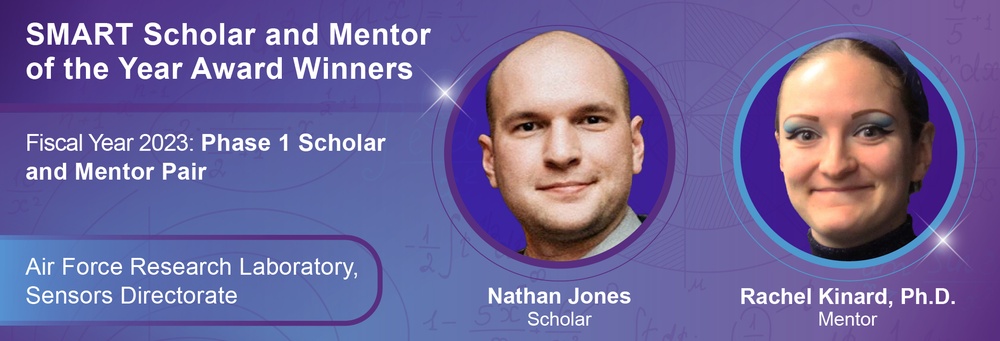It’s rare that a graduate student’s research has an impact across the Department of Defense (DoD), but for one Science, Mathematics, and Research for Change (SMART) scholar, that’s exactly what happened.
During his internship at the Air Force Research Laboratory (AFRL) Sensors Division at Wright-Patterson Air Force Base, Nathan Jones began working with his SMART mentor, Dr. Rachel Kinnard, a research mathematician at AFRL, to recreate and refactor topological data analysis (TDA) code. TDA is used to understand and analyze data by examining the shape and structure of surfaces. It has a wide range of applications, including sensor data fusion, network analysis, and predictive modeling.
For their efforts, Jones and Kinnard were awarded the SMART Outstanding Scholar and Mentor Award. This prestigious award recognizes a scholar-mentor pairing who has demonstrated exceptional dedication and achievements through their participation in the SMART program. As a Phase 3 scholar in the SMART program, Kinnard, now a Department of Defense civilian, is prepared to use his experience as a SMART scholar to mentor and support Jones throughout his internship and beyond.
Kinard discovered Jones’ previous TDA work while searching for solutions to technical challenges. After learning that Jones was a SMART scholar interning at AFRL, Kinard collaborated with Jones and other researchers to form the TDA Working Group (TDAWG). Crucially, their collaboration transformed the TDA research into working code accessible to all members of the Department of Defense.
Jones’ contributions to the TDAWG began during a summer internship, when he worked closely with Kinnard to replicate the final technical report on TDA conducted by Dr. Paul Schrader and his TDAWG colleagues. Schrader’s report used electro-optical, infrared, and acoustic modality TDA techniques for target recognition using the Air Force’s Experiments, Scenarios, Operational Concepts, and Prototype Engineering (ESCAPE) II data set. In the process, Kinnard empowered Jones to apply his TDA expertise to enhance the TDA code, resulting in a more efficient and broadly accessible product across the Department of Defense’s high-performance computing (HPC) systems.
Jones’ improvements to Schroeder’s code made it two to three times faster and more flexible, making it easier to replicate in other experiments. Jones also proposed a different approach to some calculations that made it four times faster, allowing larger images to be analyzed.
Jones didn’t stop there. He created a singularity recipe file that would allow the TDA code to be easily deployed and run on multiple DoD HPC systems, making it more accessible to other researchers within the DoD. He then shared all these improvements through a GitLab repository, allowing other researchers across the Department to access and use the tool.
Additionally, Jones wrote code to calculate metrics across the entire image set, making it easier to analyze large amounts of data. Finally, he verified that the code worked with other software, proving that the TDA pipeline he developed could be adapted to the variety of data used by the Department of Defense.
Jones attributes his success this summer to Kinard, who he credits for encouraging his development, bringing tangible value to the Air Force and providing invaluable career guidance.
Heading into the fall, the mentor pair worked with government and academic partners on three projects to further prepare Jones for his civilian career with the Department of Defense. The first project, “Meshing with Algebraic Topology: TDA Evaluation and Refinement,” focused on studying the properties and evaluation of 3D meshes and tackled the challenge of determining whether a 3D computer-aided design model is “watertight.” The concept of watertight does not have a precise definition. Jones used TDA techniques to provide a definition inspired by algebraic topology and ensure that the mesh met the criteria for being “watertight.”
The second project, Topological and Algebraic Data Analysis, builds on Schrader’s previous work by incorporating additional data from the ESCAPE II dataset, including radio frequency identification information, into the TDA pipeline. It also enhances the pipeline to study how different layers of data, such as sensor data from different sources and samples of different materials, can be combined using artificial intelligence and machine learning techniques.
Finally, in the third project, Layers for Sensor Utilization, we study layers, which are abstract mathematical objects, to analyze data fusion. The advantage of this approach is that it can handle different kinds of data and provide insights into effective ways to combine different datasets.
As a mentor pair, Jones and Kinnaird have made significant contributions across the Air Force and Department of Defense. Jones’ code is available to all members of the Department of Defense on HPC systems. Jones and Schroeder have presented their work to the entire AFRL community at Wright-Patterson Air Force Base. Their success has led to a three-year effort led by Schroeder to continually improve the TDA methodology. Their mesh work has been submitted to the International Society for Optics and Photonics, presented at the Naval Applications of Machine Learning conference in March, and their work has also spread to the Naval Research Laboratory in San Diego.
Jones will graduate from the University of Oklahoma in December 2023 with a master’s degree in mathematics sponsored by SMART. He will also begin the second phase of the SMART program, a Department of Defense civilian employment program, and continue his work at AFRL with his mentor.
Date taken: April 4, 2024 Date posted: April 4, 2024 16:13 Story ID: 467831 Location: Alexandria, Virginia, USA Web views: 82 Downloads: 0 Public domain
This work, “SMART Alumni and Scholars Awarded for Transforming Topological Data Analytics Across the Department of Defense,” must comply with the restrictions set forth at https://www.dvidshub.net/about/copyright.

